CRISPR Gene Editing: Enhanced Accuracy And Efficiency With New Modification

Table of Contents
Understanding the Challenges of Traditional CRISPR-Cas9
CRISPR-Cas9 works by using a guide RNA (gRNA) to direct the Cas9 enzyme to a specific DNA sequence. Cas9 then creates a double-strand break (DSB) at the target site, triggering the cell's natural DNA repair mechanisms. While this system is remarkably efficient, it's not without its limitations.
Off-target effects are a major concern. The gRNA may sometimes bind to sequences similar to the target site, leading to unintended mutations. This can have unpredictable and potentially harmful consequences. Furthermore, efficient delivery of the CRISPR-Cas9 system to the desired cells in vivo presents a significant hurdle. Many delivery methods are inefficient, leading to low editing rates.
Key Drawbacks of Traditional CRISPR-Cas9:
- High rate of off-target cleavage
- Limited targeting scope (difficulty reaching specific cell types or tissues)
- Inefficient delivery methods impacting overall efficacy
Novel Modifications Enhancing CRISPR Accuracy
Significant progress has been made in developing modifications to enhance CRISPR's target specificity and minimize off-target effects. These advancements are revolutionizing the field of genome editing.
High-Fidelity Cas9 Variants
Engineered Cas9 variants, such as SpCas9-HF1 and eSpCas9, exhibit reduced off-target activity while maintaining high on-target efficacy. These variants achieve increased accuracy by incorporating specific amino acid changes that strengthen the interaction between Cas9 and the target DNA sequence, making it less likely to bind to similar, off-target sequences.
Key Benefits:
- Significantly reduced off-target cuts
- Maintained high on-target editing efficiency
- Improved safety profile for therapeutic applications
Base Editors
Base editors provide a powerful alternative to traditional CRISPR-Cas9. They enable precise single-base changes without causing DSBs. This minimizes off-target effects and reduces the risk of unwanted genomic rearrangements. Cytosine base editors (CBEs) convert cytosine to uracil, while adenine base editors (ABEs) convert adenine to inosine.
Key Benefits:
- Precise single-base changes
- No double-strand breaks
- Reduced off-target effects
Prime Editors
Prime editors represent a further advancement in CRISPR technology. They combine the activity of a reverse transcriptase with a nickase Cas9 variant. This allows for more versatile and precise genome editing, including insertions, deletions, and all 12 possible base-to-base conversions. Prime editors offer substantial advantages over other methods, especially in terms of precision and versatility.
Key Benefits:
- High precision and versatility
- Ability to perform a wider range of edits
- Reduced off-target effects compared to traditional CRISPR
Improving CRISPR Efficiency through Delivery System Enhancements
Efficient delivery of the CRISPR-Cas9 system to target cells is crucial for successful gene editing. Several delivery methods exist, each with its own advantages and disadvantages.
Viral Vectors
Viral vectors, such as adeno-associated viruses (AAVs) and lentiviruses, are commonly used for gene delivery. AAVs offer high transduction efficiency in some cell types, while lentiviruses can integrate the CRISPR components into the host genome, leading to sustained expression. However, viral vectors have limitations, including immunogenicity and packaging capacity.
Non-Viral Delivery Methods
Non-viral methods, such as lipid nanoparticles (LNPs), electroporation, and other physical methods, offer alternatives to viral vectors. LNPs encapsulate the CRISPR components, protecting them from degradation and facilitating cellular uptake. Electroporation uses electrical pulses to create temporary pores in cell membranes, allowing CRISPR components to enter the cells. These methods are generally less immunogenic than viral vectors but may have lower transduction efficiency.
Comparison of Delivery Systems:
| Delivery Method | Advantages | Disadvantages |
|---|---|---|
| Viral Vectors (AAVs, Lentiviruses) | High transduction efficiency in certain cells | Immunogenicity, packaging capacity limitations |
| Non-Viral Methods (LNPs, Electroporation) | Lower immunogenicity, greater flexibility | Lower transduction efficiency in some cases |
Applications of Enhanced CRISPR Technology
The improved accuracy and efficiency of the enhanced CRISPR technologies have opened up a wide range of applications across various fields.
Gene Therapy for Genetic Disorders
CRISPR-based therapies hold significant promise for treating inherited diseases like cystic fibrosis, sickle cell anemia, and Huntington's disease. By correcting the underlying genetic defect, these therapies aim to provide a cure or alleviate symptoms.
Cancer Immunotherapy
CRISPR is being used to engineer immune cells, such as T cells, to enhance their ability to target and destroy cancer cells. This approach, known as CAR T-cell therapy, has shown remarkable success in treating certain types of cancer.
Agriculture and Biotechnology
CRISPR technology is being used to improve crop yields, enhance disease resistance, and develop new biofuels. This offers the potential to address global food security challenges and promote sustainable agriculture.
Potential Impact of Improved CRISPR:
- Cure or alleviate symptoms of genetic disorders
- Revolutionize cancer immunotherapy
- Improve crop yields and disease resistance
Conclusion: The Future of Precise CRISPR Gene Editing
Advances in CRISPR technology, particularly the development of high-fidelity Cas9 variants, base editors, and prime editors, have significantly enhanced its accuracy and efficiency. Minimizing off-target effects and optimizing delivery methods remain critical for realizing the full potential of CRISPR. These advancements have transformative implications for medicine, agriculture, and biotechnology. Stay informed about the latest developments in CRISPR gene editing and its potential to revolutionize healthcare and other industries.

Featured Posts
-
 Evaluating Trumps Two Week Timeline For Ukraine Peace
May 30, 2025
Evaluating Trumps Two Week Timeline For Ukraine Peace
May 30, 2025 -
 Kasper Dolbergs Popularitet En Analyse Af Interessen
May 30, 2025
Kasper Dolbergs Popularitet En Analyse Af Interessen
May 30, 2025 -
 Holder Vejret Vil Han Afvise Danmark En Analyse
May 30, 2025
Holder Vejret Vil Han Afvise Danmark En Analyse
May 30, 2025 -
 Setlist Fm Ticketmaster Mejor Experiencia De Usuario En Compra De Boletos
May 30, 2025
Setlist Fm Ticketmaster Mejor Experiencia De Usuario En Compra De Boletos
May 30, 2025 -
 La Fire Victims Face Price Gouging The Reality Behind Rising Rent Costs
May 30, 2025
La Fire Victims Face Price Gouging The Reality Behind Rising Rent Costs
May 30, 2025
Latest Posts
-
 Griekspoor Stuns Zverev In Indian Wells Second Round
May 31, 2025
Griekspoor Stuns Zverev In Indian Wells Second Round
May 31, 2025 -
 Griekspoor Pulls Off Major Upset Against Zverev At Indian Wells
May 31, 2025
Griekspoor Pulls Off Major Upset Against Zverev At Indian Wells
May 31, 2025 -
 Zverev Loses To Griekspoor In Indian Wells Shock
May 31, 2025
Zverev Loses To Griekspoor In Indian Wells Shock
May 31, 2025 -
 Zverevs Road To The Munich Semifinals A Comeback Story
May 31, 2025
Zverevs Road To The Munich Semifinals A Comeback Story
May 31, 2025 -
 Tallon Griekspoor Defeats Alexander Zverev At Indian Wells
May 31, 2025
Tallon Griekspoor Defeats Alexander Zverev At Indian Wells
May 31, 2025
